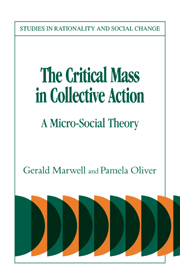Book contents
- Frontmatter
- Contents
- PREFACE
- ACKNOWLEDGMENTS
- 1 The critical mass and the problem of collective action
- 2 Building blocks: goods, groups, and processes
- 3 The paradox of group size
- 4 The dynamics of production functions
- 5 Social networks: density, centralization, and cliques
- 6 Selectivity in social networks
- 7 Reach and selectivity as strategies of recruitment
- 8 Unfinished business
- REFERENCES
- NAME INDEX
- SUBJECT INDEX
1 - The critical mass and the problem of collective action
Published online by Cambridge University Press: 19 March 2010
- Frontmatter
- Contents
- PREFACE
- ACKNOWLEDGMENTS
- 1 The critical mass and the problem of collective action
- 2 Building blocks: goods, groups, and processes
- 3 The paradox of group size
- 4 The dynamics of production functions
- 5 Social networks: density, centralization, and cliques
- 6 Selectivity in social networks
- 7 Reach and selectivity as strategies of recruitment
- 8 Unfinished business
- REFERENCES
- NAME INDEX
- SUBJECT INDEX
Summary
An atomic pile “goes critical” when a chain reaction of nuclear fission becomes self-sustaining; for an atomic pile, or an atomic bomb, there is some minimum amount of fissionable material that has to be compacted together to keep the reaction from petering out. … The principle of critical mass is so simple that it is no wonder that it shows up in epidemiology, fashion, survival and extinction of species, language systems, racial integration, jaywalking, panic behavior, and political movements.
Thomas C. Schelling (1978, p. 89)The idea of the critical mass is central to many understandings of collective action. Social movement activists, community leaders, and fund-raisers use the term when they talk about getting together enough resources to accomplish some goal. They express the understanding that it takes some minimum number of people or some minimum accumulation of seed money to draw in the participation and contributions of others. The phenomenon can also be seen in other, less intentional forms of collective action. Lynchings, wildcat strikes, and riots proceed when people become convinced that enough others are participating. Detailed observational studies of spontaneous collective action show incipient “organizers” calling to others to join their action, and they show potential participants talking to each other and reaching a common agreement about who will act (see McPhail 1971; Berk 1974; Fantasia 1988). The riot was the archetypal phenomenon of interest for early analysts of collective action.
- Type
- Chapter
- Information
- The Critical Mass in Collective Action , pp. 1 - 13Publisher: Cambridge University PressPrint publication year: 1993



